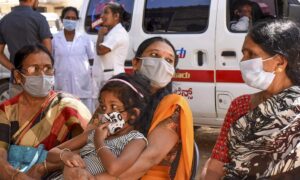New Delhi [India] India and Nepal each have received less than 1 percent of the USD 17.3 billion provided by international development funders to address air pollution between 2015 and 2021, a report shows.
Whereas, 86 percent of funding went to five nations: China, the Philippines, Bangladesh, Mongolia, and Pakistan.
The report– State of Global Aiir Quality Funding 2023–has been published by the UK-based Clear Air Fund in partnership with the Climate Policy Initiative.
This report analyses funding from international development funders between 2015 and 2021 for projects that work to improve air quality.
These funders include multilateral development banks, bilateral development agencies, and governments providing funding to low- and middle-income countries in the form of concessional and non-concessional loans, as well as grants.
The report also reveals, that only 1 per cent of international development funding ($17.3 billion) and 2 per cent of international public climate finance was committed to targeting air pollution.
“86 per cent of outdoor air quality funding provided by international development funders, or USD 12 billion, was concentrated in only five countries: China (37 percent), Philippines (20 per cent), Bangladesh (17 percent), Mongolia (6 percent) and Pakistan (6 percent),” the report states.
“According to one study, the top two countries with the highest population-weighted annual average PM2.5 exposure, globally, are India and Nepal however, these countries each received less than 1 percent of the total funding,” the report mentions.
The reports claims that the geographical concentration of outdoor air quality funding in a handful of Asian countries is due to the scale of financing provided by the Asian Development Bank (ADB); the Japan International Cooperation Agency (JICA); and the Asian Infrastructure Investment Bank (AIIB) which focuses their investments in their own region and together committed 81 percent of total outdoor air quality funding in the most recent five years for which
data is available.
“The top three cities receiving outdoor air quality funding in the most recent five years for which data is available are Beijing (27 percent), Dhaka (9 percent) and Ulaanbaatar (6%),” the report highlights.
Soumya Swaminathan Former Chief Scientist at World Health Organization (2019-2022) said the report highlights that funding to improve outdoor air quality is far too low at just 1 percent of total international development funding.
“The Clean Air Fund has shone a light on what needs attention. It sets out the opportunities for international development funders, including multilateral development institutions like the World Bank, and the role of
national policymakers and regulators in making clean air a reality,” she wrote in the report’s foreword.
Outdoor air pollution, also known as ambient air pollution, refers to the
presence of harmful substances and pollutants in the Earth’s atmosphere,
primarily generated by human activities such as industrial processes,
transportation, and energy production.
These pollutants – including particulate matter, gases like nitrogen dioxide and sulfur dioxide, ozone, carbon monoxide, and volatile organic compounds – can adversely affect human health, ecosystems, and the environment leading to various
respiratory, cardiovascular, and environmental problems.
Regions such as Latin America and the Caribbean receive significantly less funding, accounting for only 1 percent of the total during the same period, the report states.
African countries received only USD 0.76 billion in outdoor air quality funding, or 5 percent of the total, despite the fact the continent has five of the top 10 countries with the highest population-weighted annual average PM2.5 exposures, it mentions.


























